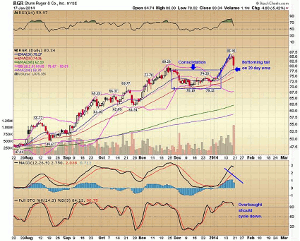Suz Smith of ExplosiveOptions.net offers an option strategy that allows you to profit from time decay and price increases by putting the trading clock on your side.
One of my favorite methods for income generation using options is to sell cash-backed puts or “naked short puts.” It is a staple trading method in my portfolio management, and with proper setup and risk management, I find it to be a low-maintenance, low-risk, and high-probability trading strategy.
Today I present Ruger (RGR) as a naked short put candidate:
On Thursday, January 16, RGR hit a new, 52-week high, an event that was met with selling. This may have been sparked by the news that CEO Michael Fifer sold 14,597 shares of the stock on Wednesday, January 8, (the shares were sold at an average price of $79.05, for a total transaction of $1,153,892.85). Oftentimes, retail investors view insider selling as a negative and think the CEO knows something that has not been publicly disclosed yet, but in this instance, it simply appears to be part of a normal exercise (as documented by the filing of his form 144, which is required by the SEC).
RGR is an exciting candidate, as there is a high short interest. As of December 31, 2013, there was a 5,352,736 short interest with a whopping 19 days to cover. The higher the short interest, the more powerful the move up can be, as nervous shorts are forced to cover at market prices. This short covering in turn begets more buying, and when that happens, the price can rapidly shoot higher, causing the price of the puts to fall. At this point, we can buy them back at a cheaper price, resulting in a profitable trade.
It is ideal to enter a short put position when volatility is high. As an options trader, I want to sell high volatility and buy low volatility. On Friday, the stock fell 5.42% (increasing volatility on the puts), but then it found support at the 20-day ema, as evidenced by the long bottom wick on the bottom of Friday’s candle.
To meet my risk parameters, I choose to sell puts that are out-of-the-money and underneath established price support and a major moving average. I stay out-of-the-money as far as possible and still take in decent premium, based on the idea that the technical character of the chart will have to change in order for my strike to get hit.
In this trade, I like the April $75 strike. As the bid/ask spread is pretty wide on the put side, I will “bid fish,” or try to get a fill in between the bid and ask. If you place your offer at the mid-line price, or in this case around $4.80, it will often be easier to get filled on the trade.
When placing this trade, there are a couple of things to keep in mind. Selling puts naked is the equivalent to being long on the stock. You are obligated to have this stock put to you at your sold strike price AT ANY TIME prior to expiration. Therefore, you only want to sell the number of puts equivalent to the number of shares you would actually want to hold in your portfolio. Proper position sizing is paramount in this strategy, as assignment can happen at ANY time, not just on the stated expiration.
The next step sounds like it is the easiest, but it is often the hardest for traders to comply with. Once you are filled on your trade, you sit and do nothing. You have to remain patient.
As the price of the stock rises and time passes by, the value of the puts will decay until you get to the point where you have made about 80% of the money (if filled at $4.80, this would mean $.96). Then you can decide if you want to roll the option to a higher strike and a later month; close the position; or let it dwindle down to pennies and then buy it back.
As long as the price of the stock is above your short strike price at expiration, you keep the maximum profits. If this trade progresses to full maturity and the put expires worthless, you will have realized a 6.4% return for sitting and doing nothing.
Selling options requires patience. Options are wasting assets, designed to go to zero on a certain date and time. This trading strategy allows you to profit from time decay and price increases by putting the trading “clock” on your side.
By Suz Smith of ExplosiveOptions.net






















